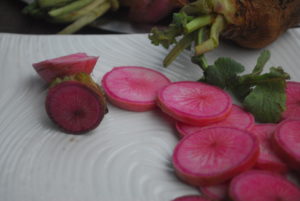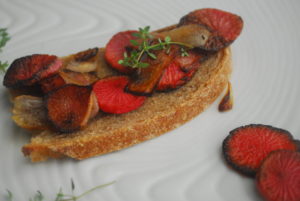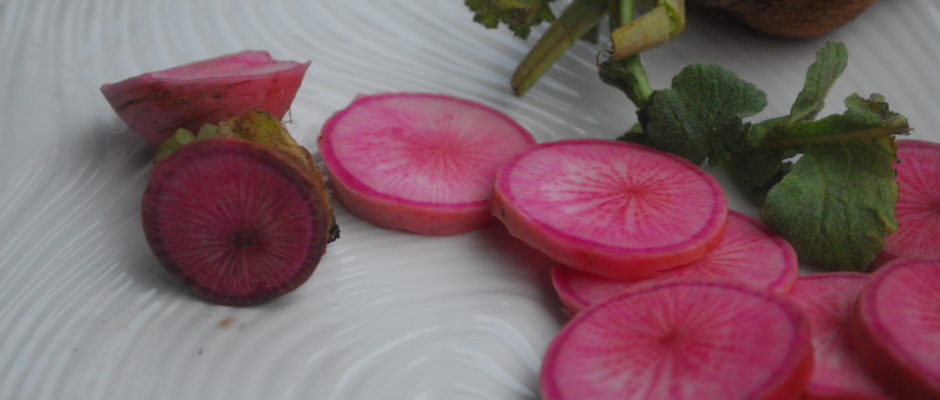Simplicity Coimbatore ,Have you tried the watermelon radish?
It’s always fun to hear of a vegetable or fruit for the first time and even better when the pictures look so pretty. I first spied the watermelon radish on a vegan food post on instagram and was instantly smitten.
It is by far one of the prettiest vegetables that I have sight eyes on. Since it was posted by someone living in the United states of America, I assumed it was a vegetable that grew there. I never gave it much thought after that .
In the month of August this year when visiting the gourmet bazaar at whispering stones,I chanced upon a stall selling organic seeds. Mr.Badri Narayan from Kodaikanal had set up a counter exclusively for selling all sorts of organic and heirloom seeds. The varieties included both edible fruits and vegetables as well as ornamental flowers. The list was rather extensive and I was suitably impressed.
While thumbing through his packets of seeds,I could hardly believe my eyes when ,among the root vegetables, he also sold seeds for the watermelon radish.He was a bit baffled on seeing my barely contained excitement.
When I asked him if these would grow locally , he replied in the affirmative. Apparently this heirloom radish variety grows in the northern states during the colder months. It has it’s origins in China where it is eaten in many dishes. Mr.Narayan said that if the soil was fertile it would grow here in Coimbatore when planted during the cooler time of year.
He believes in seed retrieval and does not source his seeds from anywhere else.In fact he is keen that whoever buys from him once should thereafter propagate seeds themselves. And his philosophy also does not support hybrid or (GM) genetically modified seeds.
It was truly a learning experience making his acquaintance and I couldn’t wait to start planting the seeds. After the September rains, the cool weather seemed ideal for sowing. The watermelon radish seeds were sown in an area which received only partial sunlight.
By mid November , the radish plants seemed mature enough to begin harvest.The lush greens kept falling prey to errant peacocks but thankfully the vegetable portion was left intact for the most part .

The watermelon radish is round in shape unlike the long tapered mullangi which we use to make sambhar here in the south.The taste and texture are also similar when eaten raw. The startling difference is in the colour. The white when cut open reveals vibrant pink centres. Some others even have a thin ring of green at the outer exterior,exactly like a watermelon.
The ones we harvested were of different hues of pink .They ranged from a bright pink to a more darker maroon.The outer skin also differed from a milk white to a deep pink. While in Asian countries, they are usually pickled or eaten raw, in western cuisine they are roasted to enhance the sweet radish flavour.
Since most of us here are used to eating radish in the cooked form, we decided to lightly saute’ it in a pan with a bit of oil.Onion slices were added for flavour. The colours looked so pretty. Coincidentally at this time we also had a packet of kodai feta cheese and some sour dough bread from a local baker. All that was left to do was pinch off a few sprigs of thyme from the pot outside and the dish looked as pretty (no other adjective will do) as a picture.If only all vegetables looked this enchanting , no parent would have to wage food wars during mealtimes ! The watermelon radish truly seems like a fairytale on the plate.

The radish also had a very slight tang which went well with the inherent sweet flavour. Mixed with the salty feta,the sour dough and the sharp herbaceous hint of thyme ,it was a light flavourful meal.
When we pair vegetables in this manner it makes for a good mid morning or evening snack or like even a light breakfast. It’s a nice break to eat something different from the usual idli/dosai staple and yet keep it local.
Watermelon radishes are documented as being an excellent source of vitamin C. Furthermore it contains isothiocyanate , a sharp chemical compound , which contributes to the pungency in taste and is also a natural pest repellent. Some farmers grow radish plants simply because these compounds are released into the ground and are naturally effective in combating weeds and harmful pests.
Growing our own food using seeds which have not been tampered with benefits not just the body but more importantly the environment we live in. That’s certainly something to think about.
Info
Badri Narayan
9611719094


No comments yet.